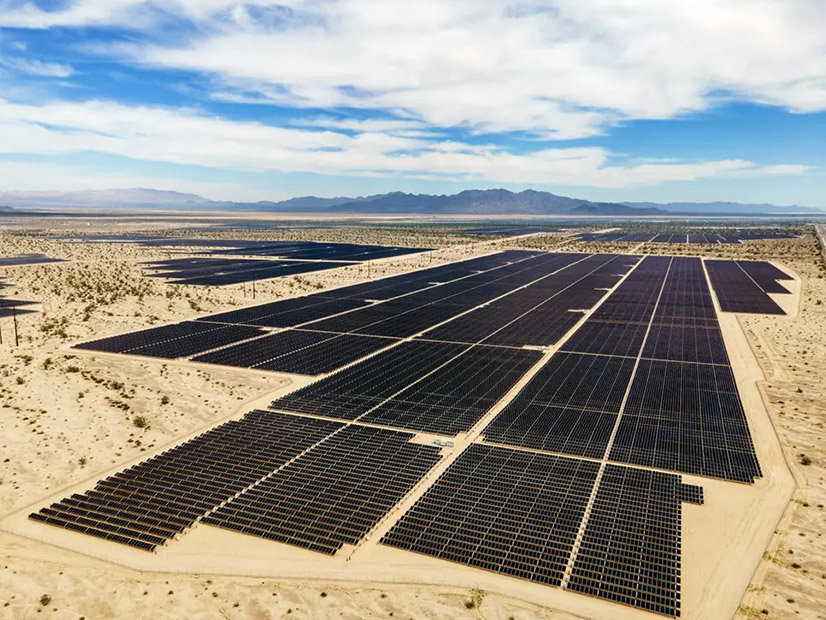
Intersect Power is seeking approval for two 1.15-GW solar-plus-storage projects in California using a streamlined permitting process available through the California Energy Commission.
If built as planned, the projects individually would surpass in size the Edwards & Sanborn solar-plus-storage project that was completed in January in California’s Mojave Desert. That project’s 875 MW of solar capacity was the most of any facility in the United States, NASA reported in January. And its 3,287 MWh of storage made it the largest energy storage facility in the world.
The Perkins Renewable Energy Project, proposed by Intersect Power subsidiary IP Perkins LLC, would be a 1.15-GW solar facility in Imperial County. It also would include up to 1.15 GW of four-hour battery storage, or up to 4,600 MWh of storage.
The Darden Clean Energy Project would consist of a 1.15-GW solar facility and 1.15 GW of four-hour battery storage. Proposed by Intersect subsidiary IP Darden I LLC, the project would be built on about 9,500 acres in Fresno County in the state’s Central Valley region.
If completed, the two projects would put a sizable dent in California’s battery storage needs — projected to be 52 GW of storage capacity by 2045. The state announced recently it had hit a milestone of 13,391 MW of battery storage. (See California Hits Milestones for Batteries, DR Grid Support.)
Streamlined Approval Process
The Perkins and Darden proposals are seeking approval through the California Energy Commission’s opt-in certification process — a voluntary process intended to streamline permitting of renewable energy projects.
Under the opt-in process, the CEC becomes the lead agency for permitting and state environmental review. The CEC certificate is in lieu of any permit that normally would be required through the local land-use review process and most state permits.
The CEC has the authority to license thermal power plants of 50 MW or larger. Assembly Bill 205 of 2022 expanded the agency’s authority to include opt-in certification for renewable energy projects such as solar, onshore wind and energy storage systems.
The Perkins project, which will sit partially on federal land, also will receive federal permitting assistance through the FAST-41 program, officials announced Oct. 15. FAST-41 is an initiative to streamline permitting through a predictable and transparent process.
Unlocking Renewables
The Darden Renewable Energy Project was discussed Oct. 16 during an environmental scoping meeting hosted by the CEC. An Intersect Power representative said the project would be on retired agricultural land that is “highly disturbed” due to its past use.
And the project has the potential to unlock more solar development in the region. Development there has been slow due to a lack of interconnection opportunities, according to Intersect.
“The Darden project would create a vital new point of interconnection for future renewable energy generators in western Fresno County by building and transferring a new 500-kV switching station to PG&E,” the company said in a presentation.
The Perkins project also would create “a vital new point of interconnection for renewable energy” in the Imperial Valley for future projects as well as Perkins, according to the project application.
Although the Darden project previously included an 800-MW green hydrogen facility, that component was removed this month. Removal of the hydrogen facility reduces the project’s operational water demand from 1,039 acre-feet per year to 35.
Opt-in Timeline
Under the opt-in certification process, the CEC is required to post a draft environmental impact report within 150 days of the date the application is deemed complete, followed by 60 days for public comment. A final EIR is due within 270 days from the application completion date.
Other state agencies that retain permitting authority over the project, such as state water boards, must decide on the application by day 360.
The Darden and Perkins projects are two of six proposals under review under the CEC’s opt-in certification process.
The other opt-in projects are:
-
- Compass Energy Storage Project: a 250-MW battery storage system in the city of San Juan Capistrano.
- Fountain Wind Project: up to 48 wind turbines, each with a capacity of up to 7.2-MW, in Shasta County.
- Potentia-Viridi Battery Energy Storage Project: a 400-MW battery storage system in eastern Alameda County providing up to 3,200 MWh of storage.
- Soda Mountain Solar Project: up to 300 MW of solar and 300 MW of battery storage in San Bernardino County.


